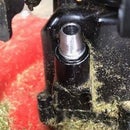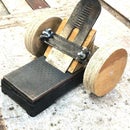Introduction: Making a Square Square
This is a good brand name square my father bought. When I used it I discovered it was not actually square. The rivet and brass system for attaching the blade to the handle is very good. No amount of tapping would change the alignment.
Step 1: Checking a Square
If you want to check a square, you could hold it up to another square, but that one could be inaccurate, too.
The dark brown piece of wood in the photo is the end section of a piece of veneer plywood I have been carrying around for several decades. The white paper arrow points to the factory cut edge of the sheet. This makes a trustworthy straightedge. The white chipboard piece of shelving raises my work surface for this Instructable to the same height as the plywood straightedge.
Step 2: Lay Down a Piece of Paper and Tape It.
This is a piece of clean scrap paper. I taped it so it does not move.
Step 3: Score a Line.
Hold the leg of the square firmly against the straightedge. With a fine point pen, mark a line along the other leg of the square for its entire length.
Step 4: Flip the Square
In geometry it is true that two lines perpendicular to the same line are parallel to each other. Flip the square over and score a second line. Make it a tiny fraction of an inch away from the first line. If the square is truly square, the lines should not diverge from each other in the least.
Step 5: These Lines Are Parallel
A close examination of the lines drawn reveals they are parallel. The square is not out of square.
But, earlier I said this square was not square when it was new. I made it square.
Step 6: A Suggested Way to Square a Square
I have never tried this method, but it is a recommended way to make a square square. Use a small punch to make dimples that force the legs of the square more open or more closed. Making a dimple where the punch is in the photo would tend to close the legs of the square slightly. Placing the punch nearer to the inside corner would tend to open the legs of the square. This could work with a flat metal square as pictured here. It would be difficult to utilize with the square in the previous photos.
Step 7: My Preferred Method
My preferred method for squaring a square involves using a file. Assume the legs of this square are open too far. The angle between the two legs is greater than 90 degrees. Make a file stroke as shown by the red line. Make another as shown by the yellow line. Make a third as shown by the green line. Make a fourth as shown by the blue line. Make yet another as shown by the azure line. Check the square for squareness often. Repeat the filing pattern until the square is truly square.













